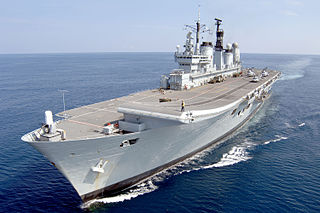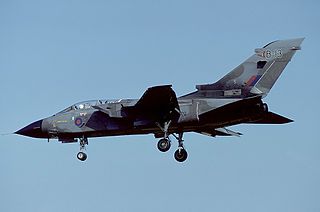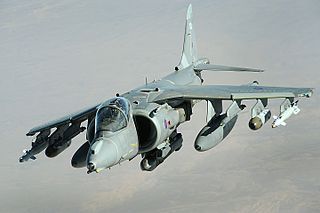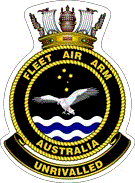Related Research Articles

The Fleet Air Arm (FAA) is the naval aviation component of the United Kingdom's Royal Navy (RN). The FAA is one of five RN fighting arms. As of 2023 it is a predominantly "rotary" force, with helicopters undertaking roles once performed by biplanes such as the Fairey Swordfish. It operates the F-35 Lightning II for maritime strike and the AW159 Wildcat and AW101 Merlin for commando and anti-submarine warfare.

The Invincible class was a class of light aircraft carrier operated by the Royal Navy. Three ships were constructed: HMS Invincible, HMS Illustrious and HMS Ark Royal. The vessels were built as aviation-capable anti-submarine warfare (ASW) platforms to counter the Cold War North Atlantic Soviet submarine threat, and initially embarked Sea Harrier aircraft and Sea King HAS.1 anti-submarine helicopters. With cancellation of the aircraft carriers renewal programme in the 1960s, the three ships became the replacements for Ark Royal and Eagle fleet carriers and the Centaur-class light fleet carriers, and the Royal Navy's sole class of aircraft carrier.

The Harrier, informally referred to as the Harrier jump jet, is a family of jet-powered attack aircraft capable of vertical/short takeoff and landing operations (V/STOL). Named after a bird of prey, it was originally developed by British manufacturer Hawker Siddeley in the 1960s. The Harrier emerged as the only truly successful V/STOL design of the many attempted during that era. It was conceived to operate from improvised bases, such as car parks or forest clearings, without requiring large and vulnerable air bases. Later, the design was adapted for use from aircraft carriers.

HMS Illustrious was a light aircraft carrier of the Royal Navy and the second of three Invincible-class ships constructed in the late 1970s and early 1980s. She was the fifth warship and second aircraft carrier to bear the name Illustrious, and was affectionately known to her crew as "Lusty". In 1982, the conflict in the Falklands necessitated that Illustrious be completed and rushed south to join her sister ship HMS Invincible and the veteran carrier HMS Hermes. To this end, she was brought forward by three months for completion at Swan Hunter Shipyard, then commissioned on 20 June 1982 at sea en route to Portsmouth Dockyard to take on board extra stores and crew. She arrived in the Falklands to relieve Invincible on 28 August 1982 in a steam past. Returning to the United Kingdom, she was not formally commissioned into the fleet until 20 March 1983. After her South Atlantic deployment, she was deployed on Operation Southern Watch in Iraq, then Operation Deny Flight in Bosnia during the 1990s and Operation Palliser in Sierra Leone in 2000. An extensive re-fit during 2002 prevented her from involvement in the 2003 Iraq War, but she was returned to service in time to assist British citizens trapped by the 2006 Lebanon War.

Royal Air Force Cottesmore or more simply RAF Cottesmore is a former Royal Air Force station in Rutland, England, situated between Cottesmore and Market Overton. On 15 December 2009, Defence Secretary Bob Ainsworth announced that the station would close in 2013 as part of defence spending cuts, along with the retirement of the Harrier GR9 and the disbandment of Joint Force Harrier. The formal closing ceremony took place on 31 March 2011, and the airfield became a satellite of RAF Wittering until March 2012.

Joint Force Harrier, initially known as Joint Force 2000 and towards the end of its life as Joint Strike Wing, was the British military formation which controlled the British Aerospace Harrier II and British Aerospace Sea Harrier aircraft of the Royal Air Force and Fleet Air Arm between 2000 and 2011. It was subordinate to RAF Air Command.

The British Aerospace Sea Harrier is a naval short take-off and vertical landing/vertical take-off and landing jet fighter, reconnaissance and attack aircraft. It is the second member of the Harrier family developed. It first entered service with the Royal Navy in April 1980 as the Sea Harrier FRS1 and became informally known as the "Shar". Unusual in an era in which most naval and land-based air superiority fighters were large and supersonic, the principal role of the subsonic Sea Harrier was to provide air defence for Royal Navy task groups centred around the aircraft carriers.

The British Aerospace Harrier II is a second-generation vertical/short takeoff and landing (V/STOL) jet aircraft used previously by the Royal Air Force (RAF) and, between 2006 and 2010, the Royal Navy (RN). The aircraft was the latest development of the Harrier family, and was derived from the McDonnell Douglas AV-8B Harrier II. Initial deliveries of the Harrier II were designated in service as Harrier GR5; subsequently upgraded airframes were redesignated accordingly as GR7 and GR9.

Royal Air Force Brawdy, or more simply RAF Brawdy, is a former Royal Air Force satellite station located 6.3 miles (10.1 km) east of St Davids, Pembrokeshire and 9.8 miles (15.8 km) south west of Fishguard, Pembrokeshire, Wales. It was operational between 1944 and 1992; it was used by the Royal Air Force and the Royal Navy (1946–1971), before the site was turned over to the British Army and renamed Cawdor Barracks.

The Fleet Air Arm (FAA), known formerly as the Australian Navy Aviation Group, is the division of the Royal Australian Navy (RAN) responsible for the operation of aircraft. The FAA was founded in 1947 following the purchase of two aircraft carriers from the Royal Navy. FAA personnel fought in the Korean War and the Vietnam War, and participated in later conflicts and operations from host warships.

800 Naval Air Squadron was a Royal Navy Fleet Air Arm carrier-based squadron formed on 3 April 1933 by amalgamating No's 402 and 404 Flights.
Commander Nigel David "Sharkey" MacCartan-Ward,, born Nigel David Ward, was a retired British Royal Navy officer who introduced the Sea Harrier Fighter, Reconnaissance, Strike aircraft to service and commanded 801 Naval Air Squadron during the Falklands War. He was known as Mr. Sea Harrier.

892 Naval Air Squadron was a carrier-based fighter squadron of the British Royal Navy's Fleet Air Arm. It was formed in 1943, flying Grumman Martlets, and was the only operational Fleet Air Arm squadron to fly the McDonnell Douglas Phantom FG.1.
801 Naval Air Squadron (NAS) was a Fleet Air Arm squadron of the Royal Navy formed in 1933 which fought in World War II, the Korean War and the Falklands War.

809 Naval Air Squadron, nicknamed the Immortals, is a squadron of the Fleet Air Arm of the United Kingdom. It was first formed in 1941 and flew in the Soviet Union, the Mediterranean and the Far East during the Second World War. After active service during the Suez Crisis, 809 was disbanded in 1959. Reformed in 1963 to fly Blackburn Buccaneers, the squadron was disbanded briefly in 1965–66, and then again in 1978. A brief period during the Falklands War saw 809 reformed to bring Sea Harrier FRS.1 aircraft south to the UK task group and to fly from HMS Illustrious.

808 Naval Air Squadron is a ship-based helicopter squadron of the Royal Australian Navy.

Ronald Cuthbert Hay, was a British naval aviator and the only Royal Marine fighter ace. He joined the Royal Marines in 1935 and then served as an aviator with the Fleet Air Arm. In 1940 he joined 801 Naval Air Squadron flying the two seater Blackburn Skua on HMS Ark Royal for the Norwegian campaign, claiming his first victory on his first operational flight. He took part in operations covering the evacuation of the British Expeditionary Force from the Dunkirk beaches. Flying the Fairey Fulmar, he joined 808 Naval Air Squadron during the Battle of Britain.

The Ferranti Blue Fox was a British multi-role airborne radar designed and built for the Royal Navy by Ferranti Defence Systems in the late 1970s. It had a mixed record in service, and was replaced by the more capable Blue Vixen.
899 Naval Air Squadron was a squadron of the Fleet Air Arm of the United Kingdom.
References
- Wilkinson, Tom (24 November 2010). "Last Harrier jet leaves Ark Royal". Independent. Retrieved 17 December 2010.